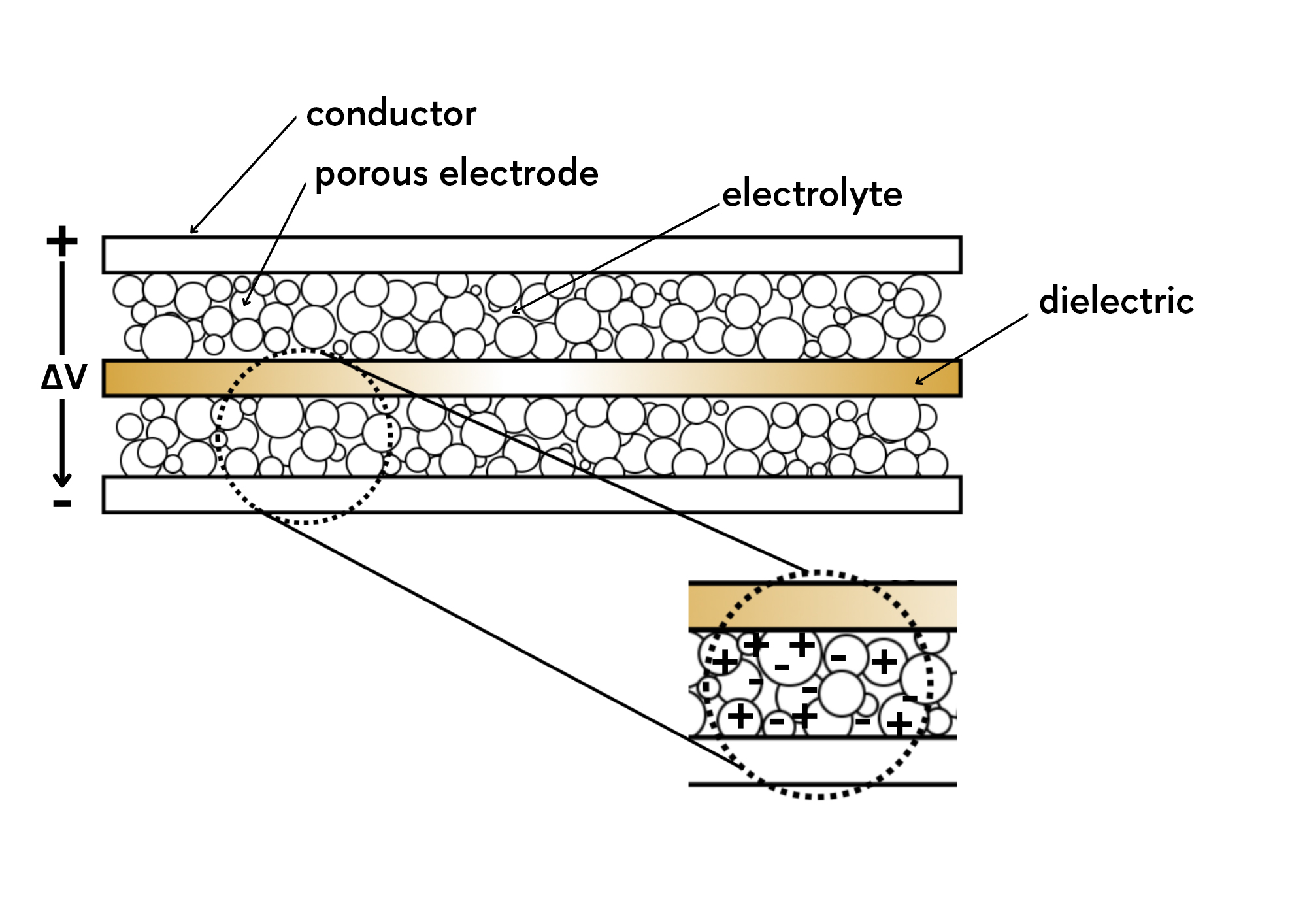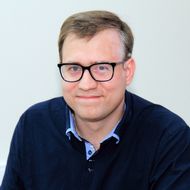HSE Scientists Have Developed a New Model of Electric Double Layer

This new model accounts for a wide range of ion-electrode interactions and predicts a device's ability to store electric charge. The model's theoretical predictions align with the experimental results. Data on the behaviour of the electric double layer (EDL) can aid in the development of more efficient supercapacitors for portable electronics and electric vehicles. The study has been published in ChemPhysChem.
Many devices store energy for future use, with batteries being among the most well-known examples. They can consistently release energy, maintaining steady power output regardless of existing conditions or load, until fully discharged.
In contrast, supercapacitors deliver power in pulses rather than in a continuous flow. If a battery can be likened to a jar that gradually stores energy for long-term use, then a supercapacitor is like a bucket that can be filled and emptied rapidly. This means that a supercapacitor can store energy for a short duration and release it instantly in a large burst.
The power of a supercapacitor depends on its internal resistance, which is notably high. This enables the supercapacitor to operate with very high currents, almost similar to a short circuit. Such a system is helpful when a quick, powerful charge is needed, and it is used in cars, emergency power systems, and compact devices. This effect is made possible by the accumulation of energy in the supercapacitor through an electric double layer (EDL).
The ability of any capacitor to store charge is determined by the area of its plates, the distance between them, and the type of dielectric material used. Since the electrolyte layer between the plates of a supercapacitor is only a few nanometres thick, and the porous coating on the electrodes provides a large surface area, supercapacitors can significantly surpass traditional capacitors in terms of stored energy.

In real-world conditions, the electric double layer is influenced by chemical interactions occurring at the quantum level. Therefore, it is essential to study both the properties of the electric double layer and the factors that influence it to improve the efficiency of electrical devices.
Scientists at HSE MIEM and the Semenov Research Centre of Chemical Physics have developed a model to describe the electric double layer at the interface between an electrode and an electrolyte solution, using a modified Poisson-Boltzmann equation for calculations. The model considers specific interactions between ions and with surrounding water molecules, the impact of an electric field on the dielectric properties of water, and the limited space available for ions at the electrode surface. This enabled a detailed description of the differential electrical capacitance profiles, measuring how effectively the EDL can accumulate charge as the voltage changes. The higher the differential capacitance, the more charge the layer can hold with small voltage changes.
The study examined aqueous solutions of sodium perchlorate (NaClO₄) and potassium hexafluorophosphate (KPF₆) at the interface with a silver electrode. The resulting model successfully predicted the structure of the electric double layer, providing insights into the capacitance behaviour at various ionic solution concentrations. An important achievement has been the successful application of the model to mixtures of the said electrolytes, demonstrating its versatility and suitability for predicting the behaviour of complex electrochemical systems.
'Our theoretical predictions perfectly match the experimental data. This is important because quantifying differential electrical capacitance during an experiment is not trivial and requires meticulous, time-consuming procedures,' comments Yury Budkov, Leading Research Fellow at the Laboratory for Computational Physics of MIEM HSE and one of the authors of the paper. 'This model will enable the prediction of differential electrical capacitance behaviour in conditions where obtaining experimental data is difficult or impossible.'
This is the first in a series of studies aimed at developing a comprehensive theory of the electric double layer at the metal-electrolyte interface as it relates to real-world systems. In the future, the authors plan to extend the model to include systems with stronger ion-electrode interactions, which are the most prevalent ones.
'Such a model will be able to account for additional factors that influence the operation of modern electrochemical devices. This is important for the development of new supercapacitors that can be utilised in a range of devices, from portable electronics to electric vehicles,' according to Yury Budkov.
See also:
Scientists Develop AI Tool for Designing Novel Materials
An international team of scientists, including researchers from HSE University, has developed a new generative model called the Wyckoff Transformer (WyFormer) for creating symmetrical crystal structures. The neural network will make it possible to design materials with specified properties for use in semiconductors, solar panels, medical devices, and other high-tech applications. The scientists will present their work at ICML, a leading international conference on machine learning, on July 15 in Vancouver. A preprint of the paper is available on arxiv.org, with the code and data released under an open-source license.
HSE Linguists Study How Bilinguals Use Phrases with Numerals in Russian
Researchers at HSE University analysed over 4,000 examples of Russian spoken by bilinguals for whom Russian is a second language, collected from seven regions of Russia. They found that most non-standard numeral constructions are influenced not only by the speakers’ native languages but also by how frequently these expressions occur in everyday speech. For example, common phrases like 'two hours' or 'five kilometres’ almost always match the standard literary form, while less familiar expressions—especially those involving the numerals two to four or collective forms like dvoe and troe (used for referring to people)—often differ from the norm. The study has been published in Journal of Bilingualism.
Overcoming Baby Duck Syndrome: How Repeated Use Improves Acceptance of Interface Updates
Users often prefer older versions of interfaces due to a cognitive bias known as the baby duck syndrome, where their first experience with an interface becomes the benchmark against which all future updates are judged. However, an experiment conducted by researchers from HSE University produced an encouraging result: simply re-exposing users to the updated interface reduced the bias and improved their overall perception of the new version. The study has been published in Cognitive Processing.
Mathematicians from HSE Campus in Nizhny Novgorod Prove Existence of Robust Chaos in Complex Systems
Researchers from the International Laboratory of Dynamical Systems and Applications at the HSE Campus in Nizhny Novgorod have developed a theory that enables a mathematical proof of robust chaotic dynamics in networks of interacting elements. This research opens up new possibilities for exploring complex dynamical processes in neuroscience, biology, medicine, chemistry, optics, and other fields. The study findings have been accepted for publication in Physical Review Letters, a leading international journal. The findings are available on arXiv.org.
Mathematicians from HSE University–Nizhny Novgorod Solve 57-Year-Old Problem
In 1968, American mathematician Paul Chernoff proposed a theorem that allows for the approximate calculation of operator semigroups, complex but useful mathematical constructions that describe how the states of multiparticle systems change over time. The method is based on a sequence of approximations—steps which make the result increasingly accurate. But until now it was unclear how quickly these steps lead to the result and what exactly influences this speed. This problem has been fully solved for the first time by mathematicians Oleg Galkin and Ivan Remizov from the Nizhny Novgorod campus of HSE University. Their work paves the way for more reliable calculations in various fields of science. The results were published in the Israel Journal of Mathematics (Q1).
Large Language Models No Longer Require Powerful Servers
Scientists from Yandex, HSE University, MIT, KAUST, and ISTA have made a breakthrough in optimising LLMs. Yandex Research, in collaboration with leading science and technology universities, has developed a method for rapidly compressing large language models (LLMs) without compromising quality. Now, a smartphone or laptop is enough to work with LLMs—there's no need for expensive servers or high-powered GPUs.
AI to Enable Accurate Modelling of Data Storage System Performance
Researchers at the HSE Faculty of Computer Science have developed a new approach to modelling data storage systems based on generative machine learning models. This approach makes it possible to accurately predict the key performance characteristics of such systems under various conditions. Results have been published in the IEEE Access journal.
Researchers Present the Rating of Ideal Life Partner Traits
An international research team surveyed over 10,000 respondents across 43 countries to examine how closely the ideal image of a romantic partner aligns with the actual partners people choose, and how this alignment shapes their romantic satisfaction. Based on the survey, the researchers compiled two ratings—qualities of an ideal life partner and the most valued traits in actual partners. The results have been published in the Journal of Personality and Social Psychology.
Trend-Watching: Radical Innovations in Creative Industries and Artistic Practices
The rapid development of technology, the adaptation of business processes to new economic realities, and changing audience demands require professionals in the creative industries to keep up with current trends and be flexible in their approach to projects. Between April and May 2025, the Institute for Creative Industries Development (ICID) at the HSE Faculty of Creative Industries conducted a trend study within the creative sector.
‘The Fundamental Principle of Scientific Knowledge Is Honesty’
Daria Mazur has wanted to pursue science since she was 13 years old—ever since she discovered in the seventh grade that she was good at physics. In an interview for the HSE Young Scientists project, she spoke about her theoretical research on the electric double layer, speed reading, and the MGMT song ‘Little Dark Age.’



